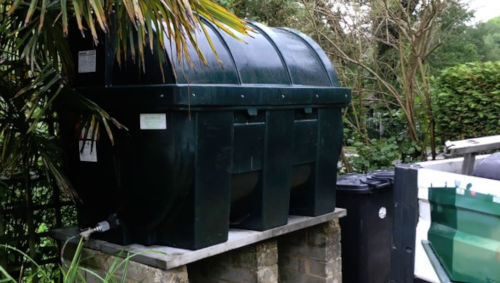
Although bunded oil tanks look solid and impenetrable, water can contaminate them if you’re not careful. The contamination can cause a range of costly and disruptive problems, which is why it’s important to be vigilant about how your oil tank holds up.
Understanding how water gets into your tank, the signs of contamination, and preventive measures can save you from these issues. In this guide, we’ll discuss everything you need to know to keep your steel or plastic oil tank water-free and in optimal condition.
How Does Water Get into an Oil Tank?
Even though single and double-skinned oil tanks are designed to be robust and durable, water can still find its way inside. Understanding the common sources of water intrusion can help you take the necessary steps to prevent it.
- Rainwater: Outdoor oil tanks are particularly vulnerable to rainwater. Poorly fitted caps, damaged vents, and even cracks can allow rain to seep into the tank.
If the tank is placed under overflowing gutters or in an exposed area, it becomes more susceptible to water ingress. - Condensation: Temperature fluctuations can lead to condensation inside the tank. When the tank’s interior is cooler than the surrounding air, water vapour can condense on the walls, eventually dripping down into the oil.
This is a common issue for both indoor and outdoor oil tanks, especially those that aren’t kept full, as the space allows more room for condensation to form. - Underground tanks: Tanks stored underground are at risk of groundwater seepage. Cracks or holes in the tank can allow water to enter, leading to contamination.
This issue requires immediate attention, as it can also lead to oil leaking into the ground, causing environmental hazards.
Problems Caused by Water Contamination
Water in your oil tank isn’t just an inconvenience; it can cause serious damage over time:
- Rust: In metal oil tanks, water can lead to rust formation, which corrodes the tank’s surface and interiors. This weakens the tank’s structure, potentially leading to leaks or even complete tank failure. Rust can also clog your furnace and fuel pump, affecting the efficiency of your heating system.
- Freezing: In colder climates, water inside the tank can freeze, blocking the fuel supply. This prevents oil from reaching your boiler, leaving you without heat when you need it most.
- Bacteria growth: Water in the tank creates a perfect environment for bacteria to thrive. This type of bacteria produces acids that corrode the tank and create sludge, which can block fuel lines and damage your boiler.
How to Prevent Water Contamination in Your Oil Tank
Preventing water contamination is far easier and more cost-effective than dealing with the consequences. Here are some steps you can take:
- Regularly inspect your domestic oil tank for signs of wear and tear, such as cracks, oil stains, and bulges. This could indicate that water is finding its way inside.
- Inspect and reconsider the place for your oil tank installation. Keep outdoor tanks sheltered from rain, and ensure they are not placed under gutters or near trees that could drip water.
- If your tank is 15-20 years old, consider investing in an oil tank replacement. Older tanks are more prone to damage and may no longer be fully watertight.
- Always ensure that the oil tank lid is securely closed and that it fits properly. Loose or ill-fitting caps are common entry points for water.
- Cut back any trees, foliage or overgrown plants surrounding your tank, as even bunded steel tanks can be prone to falling leaves or water ingress.
- Having your tank serviced by a registered oil tank service technician at least once a year can help catch any potential issues early. An experienced engineer will inspect the tank, check for water, and make any necessary repairs, or recommend that you replace your oil tank.
What to Do If You Have Water in Your Oil Tank
If you suspect or detect water in your oil tank, it’s essential to act quickly to prevent further damage.
- Contact a professional oil tank company: For large amounts of water or if your tank is difficult to access (e.g., underground), contact a registered engineer. They can safely remove the water, inspect the tank for damage, and dispose of the contaminated water appropriately.
- Remove water yourself: If the water level is minimal (less than a few centimetres) and the tank is accessible, you can remove it yourself. For metal tanks, use the sludge valve to drain the water. For plastic oil tanks, use a hand pump or a tank sponge designed to absorb water without soaking up the oil.
- Dispose of water properly: Never pour water removed from an oil tank down the drain. Instead, take it to a local waste disposal facility.
Steel and Plastic Oil Tank Servicing and Maintenance
It’s no secret that water-contaminated oil tanks can cause a host of problems. By understanding how water enters your domestic oil tank and taking steps to prevent it, you can protect your heating system and avoid expensive oil tank repairs. Regular inspections, proper maintenance, and the use of high-quality tanks can go a long way in keeping your oil tank in top condition.
If you’re unsure about the condition of your oil tank or need professional help, SG Tanks offers expert oil tank solutions, maintenance and annual servicing. Contact us today to ensure your oil tank remains water-free and fully functional all year round.
